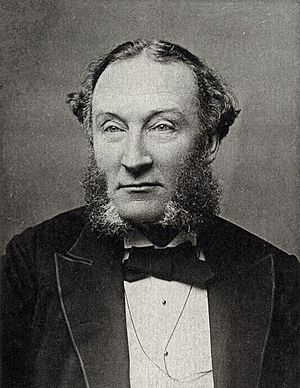Frederick William Pavy facts for kids
Quick facts for kids
Frederick William Pavy
|
|
|---|---|
 |
|
| Born | 29 May 1829 Wroughton
|
| Died | 19 September 1911 |
| Occupation | Physician, physiologist |
Frederick William Pavy (born May 29, 1829 – died September 19, 1911) was a British physician and physiologist. He is known for discovering Pavy disease. This condition causes a type of albuminuria, where a protein called albumin appears in the urine.
Life and Career
Frederick William Pavy was born in Wroughton, England. He went to Merchant Taylors' School for his education. In 1847, he began studying at Guy's Hospital. There, he worked with another famous doctor, Richard Bright. They studied Bright's disease, which is a type of kidney failure.
Pavy earned his M.B. degree from the University of London. This was after five years of study. The next year, he received his M.D. degree. He became a teacher at Guy's Hospital. In 1854, he taught anatomy. In 1856, he taught physiology. He became an Assistant Physician at Guy's in 1859. Later, in 1871, he became a full Physician.
He held many important positions during his career. In 1893, he became President of the Pathological Society of London. In 1900, he was President of the Medical and Chirurgical Society of London. He also gave special lectures. These included the Goulstonian Lectures in 1862 and the Croonian Lecture in 1878 and 1894. These were for the Royal College of Physicians. In 1863, he was chosen as a Fellow of the Royal Society. This is a great honor for scientists.
Pavy married Julia Oliver in London in 1855. They had two daughters, Florence and Maud. Frederick Pavy passed away on September 19, 1911. He was buried in his family's vault. This vault is located in Highgate Cemetery in London.
Understanding Diabetes
Pavy was a leading expert on diabetes. This is a condition where the body has trouble controlling blood sugar. He spent nearly 20 years studying it. He tried to show that a theory by Claude Bernard was incorrect. Bernard's theory was about how the body uses glycogen and glucose.
In 1862, Pavy wrote an important paper. It was called "Researches on the Nature and Treatment of Diabetes." For many years, this paper was the main guide for understanding diabetes.
Pavy also studied how the body uses carbohydrates. He looked at how diet could help treat diabetes. In 1873, he wrote a book titled A Treatise on Food and Dietetics. In this book, he suggested eating almonds and nuts. He thought they could be used instead of bread.
Pavy was a strong supporter of a low-carbohydrate diet for diabetes. His diet allowed many types of meat, except liver. It also included cheese, eggs, fish, and some green vegetables. All sugar was forbidden, including fruits, pasta, and potatoes. However, he allowed spirits and wines that were not sweetened.
Selected Writings
Frederick William Pavy wrote several important books and papers. These helped doctors and scientists learn more about the human body and diseases.
- A Treatise on the Function of Digestion (1869)
- Researches on the Nature and Treatment of Diabetes (1869)
- A Treatise on Food and Dietetics (1874)
- The Physiology of the Carbohydrates (1894)
- On Carbohydrate Metabolism (1906)
See also
- List of honorary medical staff at King Edward VII's Hospital for Officers


